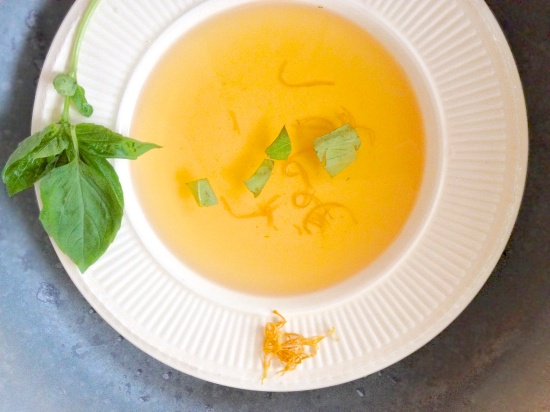
While peeling the outer leaves of a fennel bulb to expose its pearly white heart, I found my cutting board crowded with pale celery-like stalks. The leafy green tops of the soon to be discarded fennel layers inspired an aromatic broth, made with shallot skins, basil stems and lemon zest.
Ingredients
- the outer layers of one fennel bulb
- the skin of a shallot
- six to eight stems of basil
- the zest of one organic lemon
- a pinch of sea salt
- one liter of water
Bring the water to a simmer in a medium-sized pot, adding a pinch of sea salt. Cut a thin slice off the root end of the fennel bulb and cut off the stalks from the bulb, leaving the green feather tops attached. Cut the bulb in half lengthwise and remove the tough core by cutting a triangular-shape piece from the root to the middle of the bulb. Use the heart of the fennel for a crunchy winter salad or a nice vinaigrette.
Peel the shallot skin and zest the lemon. Wash the root, core and stalks of the fennel bulb in cool water, along with the shallot skin. Add all the ingredients, including the lemon zest and basil stems to the simmering pot of water, and boil for five minutes. Drain the ingredients immediately as this will ensure a mild broth.
Serve the result of your efforts in a nice bowl or large tea cup, helping you to stay warm on a grey wintry day. Add the finely chopped heart of the raw fennel bulb along with a few leaves of basil for color and structure.
♦ Suggested combinations
Use the fennel-infused broth as a base for risotto prepared with oven-braised fennel and leeks. Use it as a poaching liquid for winter vegetables like parsnip or romanesco, thus giving the vegetables cooked in this broth a subtle licorice-like lemon flavor.
♦ Notes
The broth obtained from the above ingredients keeps well for three days in the refrigerator. Its flavor is simple and clean, yet very appetizing. The result is especially pleasing because it is made with scraps of vegetables and herbs normally not used in the cooking process.